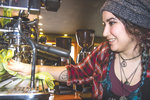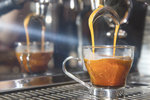Before coffee lovers can enjoy a hot cup of java, the beans must be grown, transported across the globe and roasted, a process that takes constant vigilance.
This item is available in full to subscribers.
We have recently launched a new and improved website. To continue reading, you will need to either log into your subscriber account, or purchase a new subscription.
If you had an active account on our previous website, then you have an account here. Simply reset your password to regain access to your account.
If you did not have an account on our previous website, but are a current print subscriber, click here to set up your website account.
Otherwise, click here to view your options for subscribing.
* Having trouble? Call our circulation department at 360-385-2900, or email our support.
Please log in to continue |
|


Before coffee lovers can enjoy a hot cup of java, the beans must be grown, transported across the globe and roasted, a process that takes constant vigilance.
“You have to concentrate. You can’t be distracted,” said Sue Ohlson, who co-owns Sunrise Coffee with her husband Bill Curtsinger. “If you are not paying attention, and you walk away from a source of heat, you are going to burn your coffee.”
Ohlson can often be found roasting hundreds of pounds of raw coffee beans in the rear of her shop at 308 10th St. in Port Townsend. She uses a Loring Falcon S15 roaster, which can roast about 30 pounds of coffee per batch, according to the company website.
The roaster includes several upgrades, such as touch-screen automation, over the old analog roaster Ohlson used previously, which sits nearby.
“You can get as geeky as you want or not,” Ohlson said. “I am in between. I can start to geek out on it. Before I had all this electrical stuff telling me where I was at, I did it all by sight and sound and smell. I would see my beans. You are looking at your beans as they are developing and you can tell how fast they are (roasting). I roast on the lighter end of the spectrum. I try to get more of those fruity sweeter tones out of the coffee.”
If the beans are roasted too long, they lose flavor, Ohlson said.
“You are losing all the properties,” she said.
Ohlson will roast her beans darker for certain blends or upon request, she said.
“I am also a custom roaster, so I can take this Guatemalan bean and roast it super light, medium or dark. For some people, the light roast may be a little harsh to them, whereas they love the dark roast. The darker the roast, the less caffeine.”
Picking the beans
Long before the beans reach Ohlson’s roaster, they are shipped to the United States from Africa, Central America and Asia, she said.
“It is a seasonal crop. It is different times for different places in the world. Every time of the year you are going to be getting different things coming in. In the spring, you are getting more from the South American crops.”
Regardless of the season, Curtsinger and Ohlson do research before buying any raw beans.
“We source our beans carefully,” Curtsinger said. “We only buy organic, and when we go to place an order we talk to our brokers. We have two brokers, one in Oakland and one in Seattle, and they know exactly about the bag of green beans we are interested in buying.”
When a certain type of beans grabs their attention, Curtsinger requests cupping notes, which include information about the flavor and mouthfeel of each bean once roasted and brewed.
“They have this little sampler device where they can poke into a burlap bag and take half a pound of green beans and they go into their office and have a line of 20 roasters, and roast all of the origins that came in the night before,” he said. “In the morning, they are presented to every employee of the company. They have to taste it, think about (it), and they have a form and they write down what they are tasting in each particular coffee. Those notes are really valuable to us.”
Purchased beans are shipped to Sunrise Coffee in bulk bags.
Ohlson then chooses beans from various sources to create her custom blends.
“I can come up with custom roasts for anybody,” she said. “It is like a winemaker. They come up with these amazing blends. I get to do that. You get the flavor profile that works for your clientele.
Coffee has a flavor wheel similar to wine, Ohlson said.
“There are chocolaty tones, fruity tones and acidity,” she said. “They say Sumatran is oftentimes lower in acidity than some of the other coffees.”
Making good coffee
Once quality beans have been chosen and roasted, the next step is to grind them properly, Ohlson said.
“If you put a really fine grind in a French press when it is supposed to be coarser, the harder it is to press. But some people like that. People should feel their grind, not just trust what is coming out of the machine, because sometimes somebody else at the store may set the grinder differently than what the next guy in line sets it as. That is a key thing.”
Finally, the method of preparation will affect the taste of the coffee, Ohlson said.
“Use the brew method of your choice that you prefer, because people will tell you, this is the best way to have it: drip, foam, espresso, Americano, French press. What I like to do with people is, we are going to take this Italian roast and we are going to make it through the French press, Chemex and drip filter to see how it tastes. You will get a different taste because the extraction method makes a difference.”
Ultimately it comes down to personal taste, Ohlson said.
“Even though you may have the standard coffee maker, the water pressure may be a little different, especially in this town,” she said. “Having filters on your water is important because without them you could taste the chlorine. But, if you over-filter you are taking out all of the beautiful minerals in there that will give it some of the acidity. You do want the acidity coming off your mouth because that is like the mouthfeel that they talk about.”
The infinite customization of coffee preparation, from plantation to brewing method, is what makes coffee making fun, Ohlson said.
“I try not to say, ‘You have to do it this way,’ because I don’t want people to be afraid of not making a good cup of coffee or doing it wrong. You can’t. If you want it stronger the next time, add a little more coffee or play with your grind.”
Fox Syncrow, a barista at Sunrise Coffee, said she has enjoyed learning the business of coffee roasting.
“It was unique for me because I got to learn from the ground up,” Syncrow said. “I got to see it roasted and I got to learn how to pull a really good espresso shot. There is a creative process behind every drink.”
Seeing her customers enjoy the roasted fruits of her labor gives Ohlson a sense of purpose, she said.
“It is so fun to be walking around while I am filling the bins, and people are like ‘I love your coffee. I wake up with you every morning.’”
From wholesaler to coffee shop
Sunrise Coffee began as a small wholesaler before expanding with a coffee shop, Ohlson said.
“I took this over in 1997 from Christopher John,” she said. “We were in a different place and it was strictly wholesale. I also drove for Jefferson Transit, so I would do both. And then I started building back up the business.”
The business switched from strictly wholesale about five years ago, Ohlson said.
“When I was in my other little place, it was a little narrow shotgun place and just had the beans, and the guys from the port would always come in from the co-op (and) the (Boat) Haven,” she said. “They would come in for their break and would fight for who could sit in the chair or be closest to the little roaster because it was cold. They would plunk in a quarter and get a cup of regular old drip coffee. I didn’t really care about it. It was just to pay for the cups.”
That relationship continues, Ohlson said.
“It is like a symbiotic relationship with these guys,” she said. “When I get all those beans delivered, they carry them into the shop for me. We take care of each other. I love them. It has been such a pleasure to see how the port has evolved.”
Syncrow is on a first-name basis with many customers, she said.
“We have a huge regular community because of the boatyard and the Port Townsend Marine Trades Association and a bunch of other people who found us and love us for the atmosphere as well as the coffee,” she said. “I have been here a year and it is really fulfilling.”